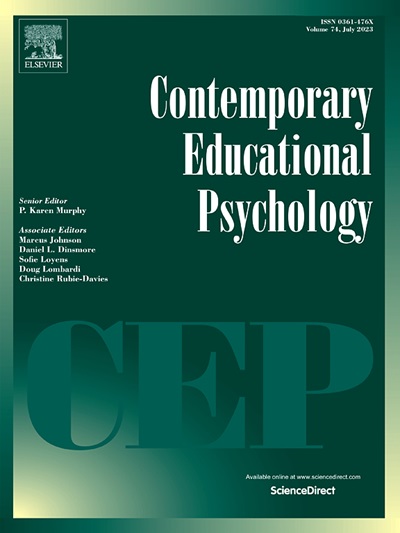不全是认可和影响:对不同高中生而言,共同目标和代理目标及动机在科学中的作用
IF 3.8
1区 心理学
Q1 PSYCHOLOGY, EDUCATIONAL
引用次数: 0
摘要
在本研究中,我们考虑了目标一致性框架与自我超越与自我导向学习动机的相关动机模型的交叉点。这两种理解学生科学学习动机的方法都呼吁人们关注公共取向(帮助他人、为社会利益工作和合作)的价值,并将其与个人主义动机(自我提升、创造财富、发展知识和技能以及获得认可)进行对比。目标一致性模型侧重于学生对科学作为一种职业的看法,而自我超越动机模型则侧重于学生对其动机的自我看法。在以拉美裔青少年为重点的不同种族高中生样本中,这些模型有助于区分科学学习动机和科学职业道路中的目标承受能力,前者更倾向于公共性和自我超越,后者更倾向于代理性和自我导向。首先,我们对建构有效性进行了评估,以了解这些通过心理测量来操作的模型是否对不同的高中生有充分的作用。接下来,我们评估了这些相互关联的动机模型是否以及如何以一种有意义的方式解释学生如何重视科学和认同科学界价值观的独特差异。我们发现,学生在科学方面的自我导向和自我超越动机以及感知到的社区目标负担能力解释了学生对科学社区价值认同的独特差异。自我导向动机对科学的内在价值、兴趣价值和成就价值具有独特的预测作用。感知到的科学社群目标负担能力可以独特地预测科学的效用价值和成就价值。而金钱和认可等更多的外在的代理目标负担则不足以在 SEM 模型中继续发挥作用。研究结果为不同高中生学习科学的具体环境提供了重要说明,既借鉴了过去的研究,又与之有所区别。本文章由计算机程序翻译,如有差异,请以英文原文为准。
It’s not all about recognition and Influence: The role of communal and agentic goals and motives in science for diverse high school students
In this study, we consider the intersections of the goal congruity framework and a related motivational model of self-transcendent versus self-oriented motives in learning. Each approach to understanding students’ motivations in science calls attention to the value of communal orientations (helping others, working for the social good, and collaboration) and contrasts them with individualistic motives (self-promotion, wealth generation, knowledge and skill development, and recognition). Whereas the goal congruity model focuses on students’ perceptions of science as a career, the self-transcendent motives model focuses on students’ self-perceptions of their motivation. In a sample of racially diverse high school students with a specific focus on Latinx youth, these models help to distinguish science learning motives and goal affordances in science career paths that are more communal and self-transcendent from those that are more agentic and self-oriented. First, we evaluated the construct validity to learn if these models, operationalized through psychological measures, function adequately for diverse high school students. Next, we evaluated if and how these interrelated motivational models explained unique variance in a meaningful way with how students value science and identify with science community values. We found that students’ self-oriented and self-transcendent motives in science and perceived communal goal affordances explained unique variance in students’ identification with science community values. Self-oriented motives uniquely predicted intrinsic value, interest value and attainment value for science. Perceived communal goal affordances of science uniquely predicted the utility value and attainment value for science. Agentic goal affordances that were more extrinsic, such as money and recognition, did not function well enough to remain in the SEM model. Findings provide important clarifications for the specific context of science learning for diverse high school students that both build on and distinguish from past research.
求助全文
通过发布文献求助,成功后即可免费获取论文全文。
去求助
来源期刊

Contemporary Educational Psychology
PSYCHOLOGY, EDUCATIONAL-
CiteScore
16.50
自引率
3.90%
发文量
74
期刊介绍:
Contemporary Educational Psychology is a scholarly journal that publishes empirical research from various parts of the world. The research aims to substantially advance, extend, or re-envision the ongoing discourse in educational psychology research and practice. To be considered for publication, manuscripts must be well-grounded in a comprehensive theoretical and empirical framework. This framework should raise critical and timely questions that educational psychology currently faces. Additionally, the questions asked should be closely related to the chosen methodological approach, and the authors should provide actionable implications for education research and practice. The journal seeks to publish manuscripts that offer cutting-edge theoretical and methodological perspectives on critical and timely education questions.
The journal is abstracted and indexed in various databases, including Contents Pages in Education, Australian Educational Index, Current Contents, EBSCOhost, Education Index, ERA, PsycINFO, Sociology of Education Abstracts, PubMed/Medline, BIOSIS Previews, and others.
 求助内容:
求助内容: 应助结果提醒方式:
应助结果提醒方式:


